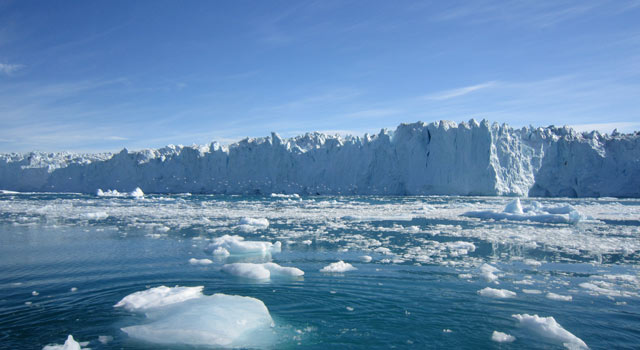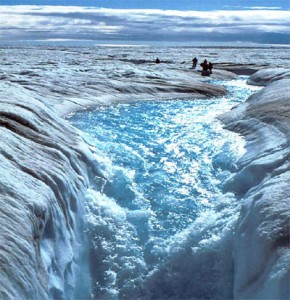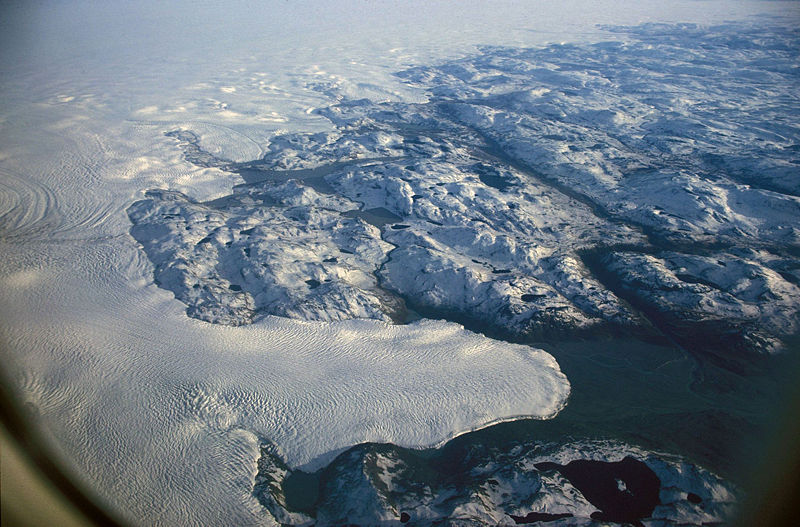Polar ice is melting more faster than predicted

The massive Greenland and Antarctic ice sheets that sit near Earth’s two poles are melting at an increasingly faster pace, a new study finds.

The study, based on measurements covering nearly 20 years, suggests the melting ice sheets are becoming the dominant contributor to global sea level rise, overtaking the loss of ice from Earth’s mountain glaciers and ice caps, much sooner than climate models had predicted.
“That ice sheets will dominate future sea level rise is not surprising — they hold a lot more ice mass than mountain glaciers,” said lead author Eric Rignot, of NASA’s Jet Propulsion Laboratory in Pasadena, Calif., and the University of California, Irvine. “What is surprising is this increased contribution by the ice sheets is already happening.”

The study examined the loss of ice mass from the Earth’s two ice sheets across several years and in 2006, a year for which there are also measurements for the ice mass lost from mountain glaciers and ice caps conducted in a different study. Ice sheets are defined as being larger than 20,000 square miles (50,000 square kilometers), and only exist in Greenland and Antarctica while ice caps are areas smaller than 20,000 square miles.
The study found that the Greenland and Antarctic ice sheets lost a combined mass of 475 gigatonnes a year on average. (A gigatonne is 1 billion metric tons, or more than 2.2 trillion pounds.) That’s enough to raise global sea level by an average of 0.05 inches (1.3 millimeters) a year. In comparison, the 2006 study of mountain glaciers and ice caps estimated their loss at 402 gigatonnes a year on average. The pace at which the polar ice sheets are losing mass was found to be accelerating rapidly.
Each year over the course of the study, the two ice sheets lost a combined average of 36.3 gigatonnes more than they did the year before. The mountain glaciers and ice caps had a year-over-year acceleration rate three times smaller than that of the ice sheets.
“If present trends continue, sea level is likely to be significantly higher than levels projected by the United Nations Intergovernmental Panel on Climate Change in 2007,” Rignot said in a statement.
Rignot and his team calculate that if current ice sheet melting rates continue for the next four decades, their cumulative loss could raise sea level by 5.9 inches (15 centimeters) by 2050. When this is added to the predicted sea level contribution of 3.1 inches (8 cm) from glacial ice caps and 3.5 inches (9 cm) from ocean thermal expansion (water expands as it warms), total sea level rise could reach 12.6 inches (32 cm). The team cautions that there are still uncertainties in estimating the acceleration of future ice loss.

Rignot’s team combined nearly two decades (1992-2009) of monthly satellite measurements with advanced regional atmospheric climate model data to examine changes in ice sheet mass and trends in acceleration of ice loss. (OurAmazingPlanet)
NASA Finds Polar Ice Adding More to Rising Seas (NASA’s Jet Propulsion Laboratory)
Earth’s Two Ice Sheets Melting Faster Than Expected, Surprising Study Finds (Our Amazing Planet)

It’s About Planet Earth’s Wobble, Stupid!
To Modify Rising Sea Levels, restore the estuaries!
Al Gore and Barack Obama and the rest of the tree huggers would have us believe that if we were to all drive these silly little Chevrolet Volts, plug in to some Rube Goldberg electric Windmill and eat bamboo shoots, that we could change global warming with its associated sea level rise. But we pragmatists know that this is not the case.
Consider: because the planet Earth wobbles on its long axis over a 23,000 year cycle, its inhabitants must endure glacial and glacial melt cycles. Glacial and interglacial periods. For instance, our Western Atlantic shoreline was 65 miles east, 11,500 years ago. Witness the carbon dated walrus tusks that scallop boats have dredged up in the Norfolk Canyon. And in another 11,500 years, our mid Atlantic shoreline will once again be on Broad Street in what was once downtown Richmond, Virginia. Witness the carbon dated whale skeleton (fossils) that have been found in and near Richmond.
Understand: As the earth wobbles on its axis, the Atlantic Ocean’s shoreline advances and recedes on a precise 23,000 year cycle. Based on the status of the polar ice cap vis a vis its line of declination to the sun. This has been going on for millions, of years. And no Obama Volt, electric windmill or government mandated bamboo shoot diet is going to change that!
However, there are some embarrassingly simple things that the current residents of today’s receding Western Atlantic shoreline can do to modify the effects of this “sea level rise”. Specifically, we should stop squandering the navigation channel dredge spoils that America’s central government is, at some considerable expense, parking in a series of ill conceived USACE (US Army Corps of Engineers) vertical dredge spoil sites. Such as Craney Island and Popular Island in the Chesapeake Bay watershed.
Instead, through the use of hydraulic rotary cutter head pipeline dredges and Rolligon amphibious ditcher-spreaders, use these navigation channel dredge spoils to reconstruct the fringe marshes and tidal creeks of Planet Earth’s coastal estuaries. And thus modify the flooding associated with major rainstorms, hurricanes and big gales caused by rising sea levels but accentuated by over a century of estuary shoreline dredging and bulkheading.
Listen! The answer to modifying the local effects of rising sea levels involves reestablishment/establishment of large, healthy fringe marshes (living shorelines). And by unblocking those tidal marshes that have been cut off from their estuaries by poorly planned roadways and rail lines.
Simply by depositing navigation channel dredge spoils on a long intertidal slope just seaward of certain bulkheads and eroded shorelines nearby, beautiful, vibrant fringe marshes could be reestablished in one short year. And by enlarging culverts that pass beneath obstructing roadways and rail lines. An added bonus: an acre of salt marsh can remove as much carbon dioxide from the atmosphere as can ten acres of (tree farm) pine or maple plantings.
There are a number of important studies on modifying the impact of rising sea levels, reestablishment of critical tidal marshland sponge effect, as well as estuary tidal water cleanup. The first is the work of former US Senator and American sportsman John Breaux. Witness: the pipeline dredging of shipping channels in the Mississippi River and placement of the associated dredge spoils, on long 1:6 intertidal slopes just seaward of eroded shorelines. So as to reestablish healthy fringe marshes. Within one year, without marsh grass planting, and without rip rap sills, new living shoreline (fringe marshes) can be established (reestablished)’. In the United States, these marshland restoration projects are ongoing or already established in Galveston Bay, in Little River Marsh, New Hampshire, in coastal New Jersey and Delaware, in coastal Louisiana, in south San Francisco Bay and elsewhere.
The second study is that of BC Wolverton, a NASA environmental engineer. Wolverton has shown that new (living shoreline) marshes can remove sediment, nitrogen, phosphorus, raw sewage, Hepatitis A viral particles, heavy metals, coliforms and PCBs from the waters that flow through them. During twice daily tidal cycles. Accordingly, water clarity is markedly improved and thus the ability to grow submerged aquatic vegetation is enhanced! In addition to restoring the vital sponge properties of tidal marshlands. Sponge properties that are essential to modify the damage caused by rising sea levels. Especially during hurricanes, during gales and during heavy rain storms.
And pipeline dredge restoration of fringe marshes could be done for practically nothing. Especially when considering the savings in disposal (repositioning) navigation channel dredge spoils….cf: instead of transporting same to some distant, government designated vertical dredge spoil deposition site.
Planet Earth needs tidal marshes, not granite rip rap sills, volunteer trash pickup programs, oyster reefs, rain barrels, expensive Bacterra storm water filers, buffer zone shrub plantings and the other feel good-do nothing projects that the tree huggers are so aggressively promoting.
Listen! To modify the effects of rising sea levels, we must reestablish the fringe marshes and unblock those tidal marshes that have been degraded by poorly planned roadways and rail lines. Once the tidal marshes are restored, the storm water will take care of itself! But not vice versa. Al Gore and Barack Obama, again, I plead with you and your collaborators to use your library cards before you offer more illogical, poorly researched concepts as those you have pushed off on an incredibly naïve public.
Pay attention, stupid! It’s about the Planet Earth’s Wobble! And about man’s dredging and bulkheading of vital (sponge) estuaries!
George Meredith MD, President
Linkhorn-Rudee Waterway Fund
To learn more about economical marshland restoration, storm water management and the sponge, search: George Meredith MD Marshland Restoration Pipeline Dredging Comments